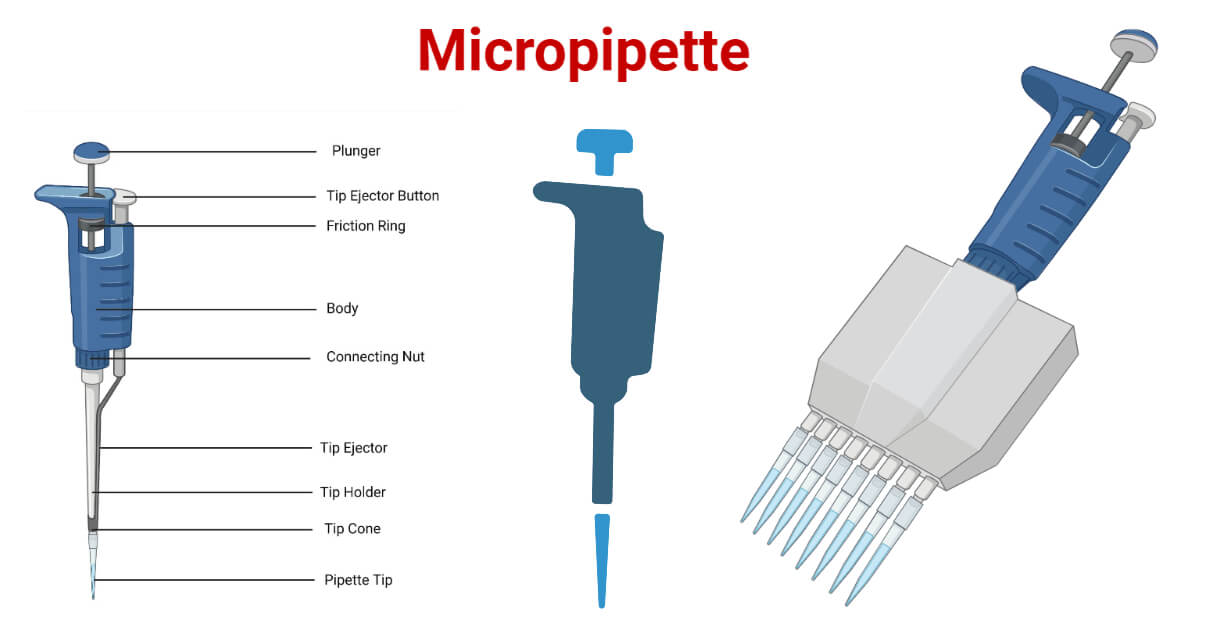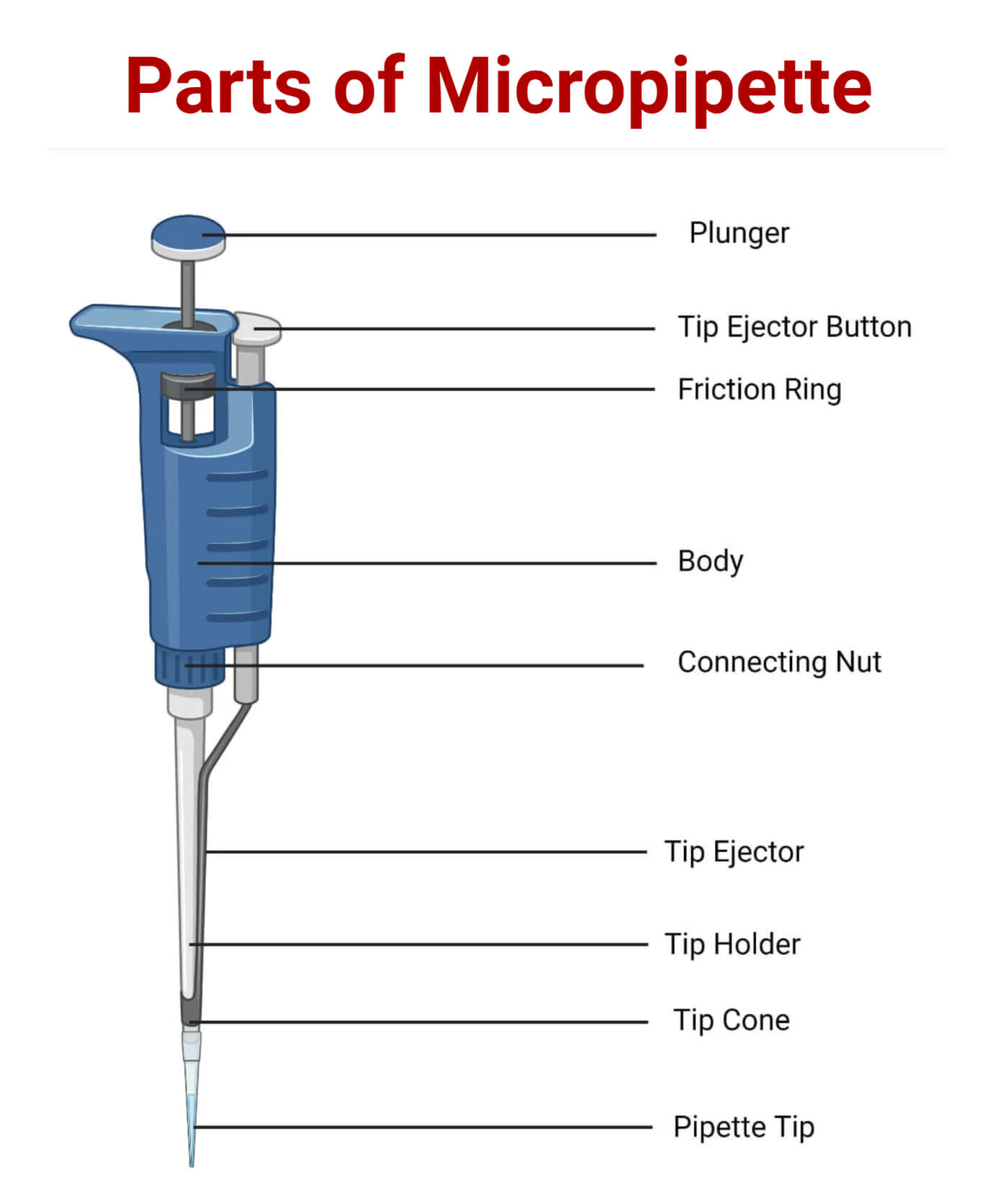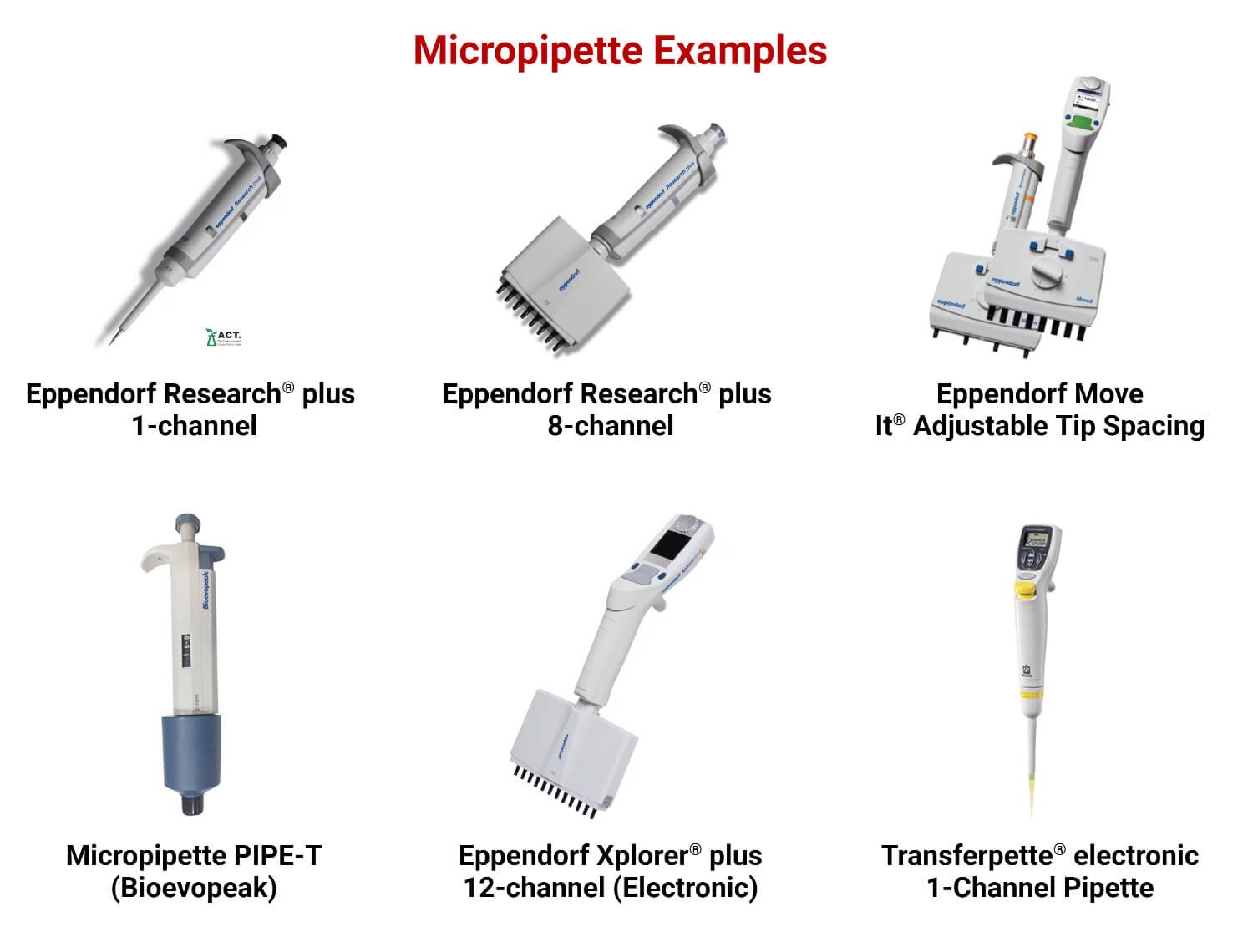One of the most important tasks in the laboratory is precise and accurate liquid handling. This task is eased by simple equipment called a micropipette or pipette.
A micropipette is laboratory equipment that is used to measure and transfer small volumes of samples, normally in the microliter range.
In the market, they come in different sizes and ranges, but their principle is the same.

Interesting Science Videos
History of Micropipette
The concept of liquid transfer using different methods was already in use. However, the precise handling of the low volume of liquid/sample was a problem. In 1957, Postdoc Heinrich Schnitger at the University of Marburg, Germany, first invented it. The first micropipette was a glass capillary tube, fragile and requiring an expert to handle it. To solve this problem, another scientist Dr. Warren Glison, in 1960 introduced piston-based adjustable micropipette, also known as Gilson Pipetman, to control the aspiration and dispense of low-volume of the liquid. This was a revolution in precise liquid handling. Since then, various companies have been modifying, refining, and introducing new features in the market.
Types of Micropipette
Types vary on the basis of features.
I) On the basis of volume, a) fixed volume micropipette b) variable volume micropipette
- Fixed volume micropipette: In a fixed volume micropipette, there is a fixed amount of liquid to be aspirated or dispensed. It is used when the task of dispensing the same volume of liquid multiple times is involved.
- Variable volume micropipette: In a variable volume micropipette, the amount of liquid to be aspirated or dispensed can be changed according to the need. It has a specific limit and range of volume that can be aspirated/ dispensed.
II) On the basis of the principle of operation, a) air displacement micropipette b) positive displacement micropipette
- Air Displacement Micropipette: In this micropipette, the piston moves towards a specific position once the volume is set. When the plunger is pressed to the first stop, the piston expels the same air volume as set initially. Once the plunger is released while immersing the tip in the liquid, the set volume is aspirated inside the tip. Likewise, for dispensing the liquid, the plunger is pressed to the first stop, and to empty completely, the plunger is pressed to the second stop. It is highly accurate for standard pipetting applications.
- Positive displacement Micropipette: In this micropipette, the piston moves down in the tip, and liquid is aspirated once the piston moves up. Likewise, the piston moves down again to dispense the set volume.
III) On the basis of the operating mechanism, a) mechanical micropipette b) electronic micropipette
- Mechanical Micropipette: They are based on the spring piston principle and are operated using hand.
- Electronic Micropipette: They are automatic. The aspiration and dispense of the sample are done with a single touch button.
IV) On the basis of the number of the channels, a) single-channel micropipette b) multi-channel micropipette
- Single-channel micropipette: They have only one channel, which is used to aspirate and dispense the sample
- Multi-channel micropipette: They have multiple channels for aspirating and dispensing the sample. It is used to reduce the workload caused by a single-channel micropipette. They might have 12 channels, 8 channels or 16 channels.
Parts of Micropipette
The basic parts of all micropipettes are:
- A plunger: It is the topmost part of the micropipette. It is used to adjust the volume, aspirate and transfer the required volume of the sample. It should be rotated clockwise or anticlockwise to increase or decrease the volume. A distinct click sound can also be heard at each volume change. One important thing is that it has two stops to pick up liquid in forward and reverse pipetting.
- A tip ejector: it is used to remove the micropipette tips easily by pressing the ejector
- A volume window: It shows the adjusted volume.
- A shaft: It is a tube filled with air that is used to push or pull the liquid
- Micropipette tips: The tips are attached to the micropipette to collect and transfer samples. There are different sizes of tips according to the adjustable volume of the micropipette.

Working mechanism of Micropipette
When the plunger is pressed, the air inside the shaft forces the liquid in the micropipette tip to expel. Similarly, when the plunger is released, the piston moves upward, and the air is replaced by the liquid, so the liquid is collected in a micropipette tip.
Applications of Micropipette
- Chemical Laboratories: They are used to handle volatile and viscous samples
- Pharmaceutical Laboratories: To assess quality control (QC) of pharmaceutical products, micropipettes are used in pharmaceutical laboratories
- Molecular biology Laboratories: Different types of micropipettes are used in molecular biology labs to perform experiments related to PCR, western blot, etc.
Uses of Micropipettes
- They are used to prepare samples and reagents.
- They are used to do slight mixing of samples by pressing and releasing plungers several times.
- They are used to add a specific volume of solvent to the sample and dilute it.
- They are used to transfer small volumes of samples from one tube to another.
- They are used to measure and dispense small volumes of samples. This process is important during ELISA, PCR, or other molecular biology experiments.
Sources of errors in Micropipette
There could be several causes that could lead to errors in micropipette. Some of them are:
- Handling error: It requires careful technique. Inconsistent pressure on the plunger, and improper attachment of the pipette tip can lead to inaccurate measurement. Likewise, misreading the volume markings on the pipette can also lead to errors.
- Tips quality: Tips that don’t fit properly on the micropipette might cause problems in the measurement. Likewise, tips incompatible with the micropipette also causes the problem.
- Liquid properties: The properties of the liquid/sample being pipetted might also cause problems in the accurate measurement. For example, highly viscous liquids stick to the wall of the tips and might not get transferred completely. Hence, it is important to check the appropriate type of pipette tips and pipette to avoid the problem caused by liquid properties
- Calibration errors: It is an important step to ensure the accuracy of the micropipette. Such errors are caused due to inappropriate calibration techniques.
How to calibrate the Micropipette?
The following steps can be applied to calibrate the micropipette:
- Allow the distilled water to be in the refrigerator to ensure the same temperature and measure the temperature of the water after a few minutes using a thermometer.
- Fill the micropipette with distilled water
- Dispense the distilled water into the weigh boat
- Use the balance to measure the weight of the dispensed water
- Repeat the process 5-10 times and record each measurement
- The formula V=Z*W can be used to calculate dispensed volume, where, V is amount of dispensed water, W is the amount of distilled water, Z is the conversion factor based on the density of water
- Calculate the average of the test results by dividing total by the number of tests
- Determine the accuracy of the pipette using the formula A= 100* Vavg /V0, where A is the accuracy, Vavg is the calculated volume, V0 is the theoretical volume to be dispensed.
Micropipette Disassembly/Teardown Video Tutorial
Limitations of Micropipette
- As it is done manually, it is error prone
- It might do damage to cells during mixing.
- If liquid comes in contact with the outside surface of the micropipette tip, cross-contamination might occur.
- It might not be accurate while measuring the volume of highly viscous liquid.
- They need careful handling. Otherwise, it might make the micropipette inaccurate and unusable.
- Its accuracy is also dependent on its handling by the user.
Examples of Micropipette
Manual micropipette 003012 series (Eppendorf SE)
- The sizes of pipettes can be identified with the help of color coding.
- To maintain sterility, pipettes are wrapped solely.
- Absence of identifiable pyrogens, DNA, DNase, and RNase.
Mechanical micropipette Move It® series (Eppendorf SE)
- It operates under the mechanical mode, is multi-channeled, and comes with variable-volume options ranging from a minimum of 0.03 ml to a maximum of 1.2 ml.
- It facilitates increased precision and durability and ensures user and sample safety through its autoclavable nature.
- It helps to move a series of samples synchronously between different vessel formats.

Mechanical micropipette PIPE-T (Bioevopeak)
- The mechanically operable, piston-type, single-channeled micropipette has a fine tip with a variable-volume feature with a maximum volume of 0.06 ml and a minimum of 0 ml.
- Availability of online calibration
- Large volume display window allows easier identification
Electronic micropipette Xplorer®/Xplorer® plus series (Eppendorf SE)
- It is electronic, multi-channeled, and features variable volumes from 0ml to 1.2 ml.
- It is easy to handle, reliable, fast operated, and precise with fatigue-free battery power.
- It has exciting additional applications, individual programming, and individual fixed-volume settings.
Electronic micropipette Transferpette® (BrandTech)
- Transferpette® is an electronic, single channeled, autoclavable and air displacement piston type micropipette.
- Pipetting, reverse pipetting, mixing, GEL-Electrophoresis, and dispensing are its five excellent programs.
- The volume of liquid that can be transferred ranges from 0 ml to 5 ml.
References
- https://microbiologie-clinique.com/laboratory-micropipette.html
- https://www.sciencedirect.com/topics/engineering/micropipette
- https://www.microlit.us/micropipette-product-guide/
- https://www.depts.ttu.edu/meatscience/docs/Calibrating-a-Pipette-7-23-20.pdf
- https://www.medicalexpo.com/prod/eppendorf-se/product-68382-962374.html
- https://www.medicalexpo.com/prod/eppendorf-se/product-68382-962346.html
- https://www.medicalexpo.com/prod/eppendorf-se/product-68382-962426.html
- https://www.medicalexpo.com/prod/bioevopeak/product-301335-1050955.html
- https://www.medicalexpo.com/prod/brand/product-83753-662777.html

